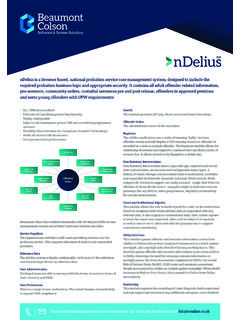Transcription of Prison Management System (PRISMS) - NISG
1 Case Studies on e-Governance in India 2012 - 2013 Prison Management System (PRISMS) An e-Governance Project of the Govt. of Goa Osama Manzar Case Studies on e-Governance in India 2012 - 2013 Prison Management System (PRISMS) An e-Governance Project of the Govt. of Goa Osama Manzar Case Studies on e-Governance in India 2012 - 2013 Page | i About the Initiative This publication is a part of the Capacity Building initiative under the National e-Governance Plan (NeGP) by NeGD with an aim to draw out learnings from various projects implemented in various States/ UTs and sharing this knowledge, in the form of case studies, with the decision makers and implementers to benefit them, by way of knowledge creation and skill building, from these experiences during planning and implementation of various projects under NeGP. Conceptualised and overseen by the National e-Governance Division (NeGD) of Media lab Asia/DeitY these case studies are submitted by e-Governance Practitioners from Government and Industry/Research Institutions.
2 The cases submitted by the authors are vetted by experts from outside and within the Government for learning and reference value, relevance to future project implementers, planners and to those involved in e-governance capacity Building programs before they are recommended for publication. National Institute for Smart Government (NISG), working on behalf of this NeGD provided program Management support and interacted with the authors and subject matter experts in bringing out these published case studies. It is hoped that these case studies drawn from successful and failed e-Governance projects would help practitioners to understand the real-time issues involved, typical dilemmas faced by e-Governance project implementers, and possible solutions to resolve them. Acknowledgment NISG sincerely thanks all the authors for documenting and sharing their rich experiences in terms of challenges and lessons learned and allowing us to publish and use these case studies in various training programs of NeGD and NISG.
3 NISG also thanks all the external and internal experts who helped review the submitted cases, providing critical observations and for helping in articulating and presenting the case studies, both for class room use as well as a reference article. Copyright License This case study submitted by author/s and accepted for publication under the project of National e-Governance Division (NeGD), Ministry of Communications and Information Technology, Government of India by NISG, the program Management agency, is governed by the following license of the Creative Commons. For any specific permission/feedback the publisher may be contacted. (cc) Creative Common License - Attribution-Share Alike Generic The user is therefore free to make derivative works, with credit to the original author. Case Studies on e-Governance in India 2012 - 2013 Page | ii Disclaimer This publication is a work product produced by external authors with information sourced from their own sources as provided under reference in respective articles and is based on experiences with Projects undertaken directly or as research initiatives closely working with the project owners or with their consent to publish the findings.
4 The authors have provided a plagiarism declaration as per project guidelines and National Institute for Smart Governance (NISG) has put in best efforts to validate the authenticity and learning value of the article submitted. NISG has acted mainly as a content reviewer with support from identified expert resources. NISG is not responsible for any plagiarism violations or copyright infringements and respective authors are fully responsible for the same as per respective declarations provided by them. The case study should not be used as a definite source of data. The case studies are meant for use as a background and quick reference on the topic(s) by e-Governance practitioners, and should not be treated as a guideline and/or instructions for undertaking the activities covered under any e-Governance project/s. It may also be used in a classroom for discussion by the participants undergoing e-Governance related training programs.
5 The document by no means has any commercial intention and is solely developed for the purpose of knowledge sharing. NISG-CBKM 63-200/Case Study/10-2014/V2 Printed & Published by National Institute for Smart Government on behalf of the National e-Governance Division (NeGD) Department of Electronics & Information Technology Ministry of Communications & IT Government of India Case Studies on e-Governance in India 2012 - 2013 Page | iii Table of Contents 1. Abstract .. 1 2. Keywords .. 2 3. Project Background .. 2 4. Project Description .. 4 5 Stakeholders .. 6 Services Offered .. 6 Outcome & Benefit of PRISMS .. 8 5 Issues and challenges faced during implementation .. 10 Implementation strategy / methodology: .. 10 Change Management : .. 11 6 Key lessons .. 13 7 Methodology adopted for case writing .. 14 8 References .. 14 Author .. 15 Project Case Fact Sheet .. 17 Case Studies on e-Governance in India 2012 - 2013 Page | 1 1.
6 Abstract The Prisons Management Systems (PRISMS), a landmark e-governance initiative of Goa government has not only been pioneering but also influential in many such initiatives in other states as far as automation and efficiency of Prisons Management is concerned. PRISMS are an effective ICT-enabled Prison administration and Management System with the objective of providing an easy effective and efficient mechanism benefiting the prisoners and the concerned Prison department. This case study aims to bring forth the importance of Government Process reengineering (GPR) in the context of implementing ICT systems and the resultant benefits to stakeholders. The period prior to implementation of PRISMS was marked by multiple complexities and hurdles including manual based time consuming process, human errors, insufficient security due to time consuming record keeping, difficulty in managing visitors, faulty calculation of correct remission and release dates, delay in application process, negligence of records and so on.
7 The shortcomings fostered corrupt and inefficient administration and compromised constitutional rights of prisoners and the rule of law. Post PRISMS, implementation has weeded out key limitations of prisons Management in Goa resulting in drastic improvements in Prison administration and in the lives of the prisoners. Whereas PRISMS has emerged as a source of tremendous positive change among the stakeholders, it has also established its sustainability on the basis of being cost-effective. However, PRISMS has had its own share of challenges and limitations; for example, difficulty in motivating the staff in the new System , System design and deployment with 23 diverse modules, network building, and ensuring System foolproof and monitoring. The objective of the case study is to analyze PRISMS, implemented in jails and judicial lock-ups all over Goa by the Office of the Inspector General of Prisons. The analysis is divided into 5 major sections and focuses on a detailed analysis of the pre-implementation state of the project, the current status with respect to the proper functioning and benefits provided by the System , challenges and lessons learnt during the implementation phase.
8 In terms of methodology, secondary as well as primary data was collected, including interviews of representative stakeholders, namely the office of the Inspector General of Prisons, GEL the agency that designed and implemented the solution, the Prison Management staff, and the officers working with the System as well as the prisoners. The findings arrived through this case study point towards the positive impact of e-governance programs with regard to integrated and holistic Prison Management . Case Studies on e-Governance in India 2012 2013 Page | 2 2. Keywords PRISMS, Prison Management , e-governance, web-based application, efficient administration, parole, compensation, Goa Electronics Limited, ICTD, Smart Government, India, Automation, PR. 3. Project Background Prison Management is a daunting task and especially when the numbers are too high to handle, resources are minimal to manage and there is lack of trained manpower to manage pressures and crisis situations.
9 In case of Goa, two major set of challenges were identified in relation to Prison affairs Management . One challenge was from the Prison administration perspective. The manual Prison administration was plagued by ills of a traditional administrative and Management structure. These included time consumption process, human errors in administering records and registers of Prison inmates, and Management hurdles in compilation and analysis of data due to lack of data and information accuracy1. For example, the manual visitor s Management could not track photographs of visitors, fingerprints taken were not recorded, difficulty to track the previous convictions of the inmates with regard to other trials pending and so on. Remission, release and bail calculations were extremely time consuming and prone to data and information errors. Human errors in information and data Management amounted to 40 % to 50 % of total defaults.
10 Overall, the impact from these was no less disturbing. Sharing of accurate data and information within the department and other stakeholders was a problem. Right decisions at right time could not be taken when needed. The challenge was rule of law could not be successfully implemented. 1 During the study work conducted in May 2012, Mr. MihirVardhan, head of Goa State Prison and collector of North Goa and Director General of the Prisons Department Goa, gave his views thus (May 27, 2012) Organisational Structure Central Jail - Aguada Sub Jail - Sada 4 Judicial lock-ups Margao, Panaji, Mapusa & Sada Prison population 450 to 500 Case Studies on e-Governance in India 2012 2013 Page | 3 The bigger challenge was in record Management of no less than 23 activity functions related to Prison and prisoners. These included areas like prisoners information, court related information, remission Management , prisoner admission and release, detention of under-trials, prisoners work allotment and monitoring, prisoners medical Management , victim compensation, parole and furlough Management , Prison reforms, and so on.











